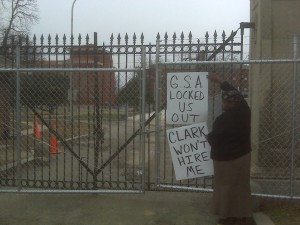LISTEN TO VOICES FROM DC JOBS OR ELSE

Audio clip: Adobe Flash Player (version 9 or above) is required to play this audio clip. Download the latest version here. You also need to have JavaScript enabled in your browser.
If you don’t have economic democracy, you can’t have political democracy. – Donald Temple, civil rights attorney
Unemployment in D.C.’s Ward 8 is at least 18 percent. In the midst of the job insecurity east of the Anacostia River the federal government is undertaking its largest project in the U.S.
Construction has begun on the Department of Homeland Security’s $3.4 billion headquarters on the 176-acre West Campus of the former St. Elizabeth’s hospital.
March 30, more than a hundred local residents gathered in the basement of Matthews Memorial Baptist Church. Before marching to St. Elizabeth’s, Raymin Diaz, an organizer with DC Jobs Or Else, addressed the gathering: “This is a movement about demanding jobs for D.C. residents.”
Yango Sawyer, co-founder of the Coalition of Returning Citizens, followed Diaz. “You are the vanguard of this movement… You’re in front. That means you can’t get discouraged… Dr. King started marching, protesting in the south ’cause we couldn’t eat besides some other folks. We couldn’t work besides some other folks. But it worked. And this right here will work also.”
As the march made its way to St. Elizabeth’s, Sawyer explained the significance of the latter part of the group’s name, DC Jobs Or Else. “Or else nobody else will work. We’ll shut the sites down… We [are] talk[ing] about doing the same thing that Dr. King and a number of other folks did around the country in terms of making jobs available for black and poor folk during the ’60s and the ’70s.”
The General Services Administration is overseeing the construction of the St. Elizabeth’s site. Marchers planned to visit the GSA Opportunities Center on the grounds of St. Elizabeth’s in order to hand in job applications.
According to the February GSA Opportunities Center Newsletter, “The Opportunities Center opened for business in February 2010 and has stayed true to its main mission of raising awareness about the objectives of the Consolidation Project. Going forward, the Opportunities Center will continue to work on involvement in the Ward 8 community. The Center’s objectives of employment, training, subcontracting opportunities, and tours for community and agency stakeholders ring true today as they did a year ago.”
Last week’s marchers, however, were surprised to find the gates to the Opportunities Center closed at a time when the Center was scheduled to be open. Diaz said, “Clearly, if they shut the gate on us today… they’re reacting to what we’re doing. It seems to me like they’re scared. They know that we’re getting organized and we’re coming back at them.”
TheFightBack’s questions to GSA – about the closure and other issues – have so far gone unanswered.
Standing in front of the locked gate with bullhorn in hand, Donald Temple, a civil rights attorney, asked marchers to get down on their knees and “pray in your silent way as we struggle here for jobs and for decent living standards for people in this community, just outside the backdoor of the White House.”
Temple said, “You can’t build a [$3.4 billion] project in this community and then tell us that we can’t participate in the benefits of that. This is not South Africa and apartheid. This is Washington, D.C… You’re not going to build it and take this city… and move us away and then don’t give us the opportunity to [work]. We’re here to stay.”
Back at the church following the march, Temple said, “Damn if there’s not electricians in Ward 8. Damn if there’s not carpenters in Ward 8. It’s not that we don’t have the skill set. We got plumbers. We got carpenters. We got laborers. I mean what does it take to move some dirt?
“So we got to keep struggling and struggling and struggling and some point the gate is going to be open. Some kind of deal has got to be cut… We don’t want Washington to be a place when all this is done and said where everybody that looks like us has got to live in Charles County.”
